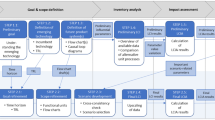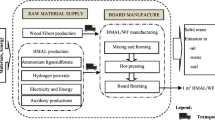Abstract
Purpose
Lignin is a by-product of wood pulping that is normally used as fuel on-site (black liquor), but also has some applications in the field of new biomaterials. This study focuses on the life cycle inventory of lignin originating from the kraft pulping process, for polymer applications. The system boundary includes lignin precipitation from black liquor, washing, and drying, but excludes subsequent application-specific compatibilization modifications. Lignin transportation is considered to rely exclusively on trucking.
Methods
This work is based on the ecoinvent v2.2 database and the IMPACT 2002+ impact assessment method. Special attention is given to the net effect of lignin precipitation on the mass and energy balances of the kraft process. Because the kraft black liquor supply will far exceed the demand for non-fuel uses for the foreseeable future, it is considered appropriate to use either the marginal variation method of physical allocation or a system boundary expansion. Consequently, the system boundary includes natural gas as a substitute fuel (when applicable) but excludes wood harvesting and the pulping process.
Results and discussion
The main impacts of kraft lignin come from the natural gas subsystem (fuel substitution and drying) despite a significantly cleaner combustion than for black liquor. Other significant contributors include the production of carbon dioxide for precipitation, sulfuric acid for washing, and sodium hydroxide to make up for sodium losses, all of which have some improvement potential.
Conclusions
The environmental profile of kraft lignin tends to be preferable to synthetic organic compounds of similar molecular complexity because its initial transformation chain is relatively energy efficient. It is thus an environmentally sound choice for polymer applications as long as near-unity substitution ratios can be achieved without requiring compatibilization modifications that are too environmentally intensive and without affecting other stages of the product life cycle. In particular, the end-of-life performance depends on long-term lignin sequestration.



Similar content being viewed by others
References
Bernier E, Lavigne C, Robidoux PY (2011) Analyse du Cycle de Vie en partenariat avec Enerlab 2000 inc d’une mousse de polyuréthane rigide: Étude du berceau-à-barrière de la substitution du polyol par de la lignine. National Research Council Canada, Montreal
Caduff M, Althaus H-J, Abächerli A, Lora JH (2010) LCA study of lignin as raw material for ecobinders. Empa, International Lignin Institute and Granit Recherche Développement SA, Duebendorf
Doherty W, Mousaviouna P, Fellows C (2011) Value-adding to cellulosic ethanol: lignin polymer. Ind Crop Prod 33(2):259–276
Holladay J, Bozell J, White J, Johnson D (2007) Top value-added chemicals form biomass. Volume II—results of screening for potential candidates from biorefinery lignin. Pacific Northwest national Laboratory, Richland, WA
IPPC (2001) Integrated Pollution Prevention and Control (IPPC)—reference document on best available techniques in the pulp and paper industry. European Commission, Seville
ISO (2006) International Standard 14044: environmental management—life cycle assessment—requirements and guidelines. International Organization for Standardization, Geneva
Jolliet O, Margni M, Charles R, Humbert S, Payet J, Rebitzer G, Rosenbaum R (2003) IMPACT 2002+: a new life cycle impact assessment methodology. Int J Life Cycle Assess 8(6):324–330
Jolliet O, Saadé M, Crettaz P (2005) Analyse du cycle de vie: comprendre et réaliser un écobilan. Presses polytechniques et universitaires romandes, Lausanne
Kouisni L (2011) Method for separating lignin from black liquor. U.S. Patent Application No. 20110297340. U.S. Patent and Trademark Office, Washington
Kouisni L, Fang Y, Paleologou M, Ahvazi B, Hawari J, Zhang Y, Wang X-M (2011) Kraft lignin recovery and its use in the preparation of lignin-based phenol formaldehyde resins for plywood. Cellul Chem Technol 45:515–520
Lautier A, Bernier E, Lavigne C, Robidoux PY (2010) Life cycle assessment of plywood and OSB resin: substitution of phenol by lignin. National Research Council Canada, Montreal
Modahl IS, Brekke A, Raadal HL (2009) Life cycle assessment of cellulose, ethanol, lignin and vanillin from Borregaard, Sarpsborg. Østfoldforskning AS, Kråkerøy
Pessala P, Schultz E, Kukkola J, Nakari T, Knuutinen J, Herve S, Paasivirta J (2010) Biological effects of high molecular weight lignin derivatives. Ecotoxicol Environ Saf 73:1641–1645
Wiesenberger H, Kirchner J (2001) Stand der Technik in der Schwefelsäureerzeugung im Hinblick auf die IPPC-Richtlinie. Federal Environment Agency, Vienna
Wising U, Algehed J, Berntsson T, Delin L (2006) Consequences of lignin precipitation in the pulp and paper industry. Tappi J 5(1):3–8
Acknowledgments
The authors would like to thank Brian Richardson, Lamfeddal Kouisni, and John Schmidt at FPInnovations and Zoé Périn-Levasseur at CanmetENERGY (Natural Resources Canada) for their valuable input in completing the mass and energy balances, as well as people at the National Council for Air and Stream Improvement (NCASI) for advice on emissions to water.
Author information
Authors and Affiliations
Corresponding author
Additional information
Responsible editor: Seungdo Kim
Rights and permissions
About this article
Cite this article
Bernier, E., Lavigne, C. & Robidoux, P.Y. Life cycle assessment of kraft lignin for polymer applications. Int J Life Cycle Assess 18, 520–528 (2013). https://doi.org/10.1007/s11367-012-0503-y
Received:
Accepted:
Published:
Issue Date:
DOI: https://doi.org/10.1007/s11367-012-0503-y




